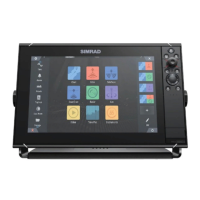Ú
Note: The autopilot must be commissioned prior to first use and any time after autopilot
default settings have been restored.
Cable steer calibration
Ú
Note: The rudder source must be set to rudder feedback to be able to run this
calibration
Start the calibration process by selecting the rudder feedback calibration option, and follow
the onscreen instructions.
Ú
Note: When centering the motor during the calibration process, ensure that the motor is
centered visually when the dialog shows 0 value. If not, center the motor visually before
pressing OK to align the physical position with the dialog value.
When the calibration process is completed, select the rudder test option to confirm the
calibration.
If the calibration does not pass the rudder test:
• confirm that motor is moving
• confirm that the rudder feedback reading moves according to motor rotation
• check the NAC-1 drive cable
• confirm that the motor can be manually moved smoothly in each direction
• check for other mechanical issues
• check wiring connections
• repeat the rudder calibration.
Hydraulic system calibration
Virtual rudder feedback (VRF) calibration is used for vessels with hydraulic steering when no
rudder feedback is available.
Ú
Note: The rudder source must be set to VRF to be able to run this calibration.
Start the calibration process by selecting the VRF calibration option, and follow the onscreen
instructions.
Ú
Note: When the autopilot attempts to turn the motor during the calibration process,
ensure that the motor movement is noticeable and that the motor is turning in the
correct direction before selecting Yes on the dialog. When No is selected, the NAC-1
reverses direction and increases power the next time it turns the motor during the
calibration process.
Ú
Note: You may have to select No more than once to ensure the pump provides enough
power to turn the motor at high boat speed.
Steering response
Used to increase or decrease the steering sensitivity. A low response level reduces the rudder
activity and provides a more loose steering. A high response level increases the rudder
activity and provides more tight steering. A too high response level will cause the boat to
make S movements.
NAC-2/NAC-3 specific installation settings
For setup and commissioning of the NAC-2 or NAC-3, refer to the commissioning manual
included with the autopilot computer.
AC70/AC80 Specific installation settings
The AC70/AC80 computers do not have any specific installation settings available in the
MFD.
Ú
Note: The MFD cannot be used to configure or commission an AP70/AP80 system. For
more information, refer to the documentation included with the autopilot system.
34
System setup | NSS evo3S Installation Manual

